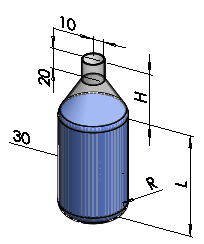|
Evaluation
|
You specify discrete values for each variable and use sensors as constraints. The software runs the study using various combinations of the values and reports the output for each combination.
For example, for this multibody model of a water bottle, you specify values of 75mm, 100mm, and 150mm for the length (L); 30mm, 55mm, and 80mm for the height (H); and 10mm and 20mm for the radius (R). You specify a Volume sensor to monitor the volume of the water body. The Design Study results report the volume of the water for each combination of L, R, and H.

|
|
Optimization
|
You specify values for each variable, either as discrete values or as a range. You use sensors as constraints and as goals. The software runs iterations of the values and reports the optimum combination of values to meet your specified goal.
For example, for the model above, you specify a range of 75mm to 150mm for the length (L); discrete values 30mm, 55mm, and 80mm for the height (H); and a range of 10mm to 20mm for the radius (R). For a constraint, you specify a Volume sensor to keep the volume of the water body between 299000mm^3 and 301000mm^3. For a goal, you use a Mass sensor and specify to minimize the mass of the bottle. The Design Study iterates on the values specified for L, R, H, and Volume, and reports the optimum combination to produce minimum mass.
|